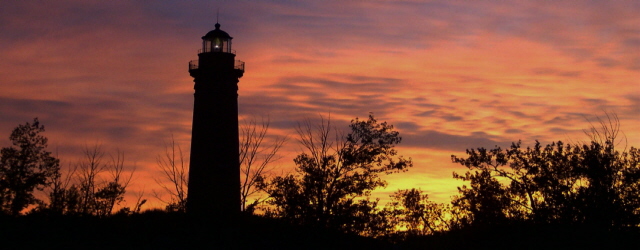LIGHTHOUSE "CHARACTERISTIC" - Lighthouses have two major purposes. They alert mariners to hazards along the coast such as submerged ledges, rocky outcrops, or shallow shoals; they also serve as landmarks by which to navigate. To accomplish these purposes, a lighthouse must appear different, both by night and by day, than any other lighthouse that can be seen from a given point. These differences are referred to as the "characteristic" or the "signature" of the lighthouse. One of the first methods of making one light appear different from another was to build two lighthouses at the same location, thus a mariner would see a double light at night. The obvious disadvantage of this was the huge cost and expense of building, maintaining, and operating two lighthouses instead of one, particularly in the days when each might have up to a dozen or more lamps. In a few instances, three separate lighthouses were built at the same place. Other early methods of distinguishing one light from another was to somehow make the lenses rotate so that the intensity of the beam varied from moment to moment. The use of opaque or even colored screens in front of some or all of the lamps was tried in some locations. With the eventual coming of the hugely efficient Fresnel lenses to our lighthouses, the ability to alter the appearance of the lights was greatly simplified.
Some lighthouses displayed a "fixed" light, in that the the lens did not rotate nor the light change in appearance. It was simply "on" and cast a shaft of light out over the water. The largest "first order" Fresnel lenses often surrounded fixed lights as they were so big and bright they could not be mistaken for some other lighthouse. But the majority of lighthouses had lights that appeared to the viewer from a distance to be "flashing". In the days of oil lamps, the lamp itself was of course not turning on and off. Some lenses were made with multiple "bulls-eye" sections, and as the lens rotated the light would appear to give a bright "flash" as the bulls-eye section of the lens passed between the light source and the viewer. This would then be followed by a period of lesser light intensity until the next bulls-eye section of the lens passed by the light. The number of seconds between apparent "flashes" was the “signature” of this particular lighthouse. This information would be found on mariners' navigational charts. Sometimes colored glass panels were either in the lens or in the glass of the lantern, and these gave the light either a continuous color (red and green the most common) or an alternating white and colored appearance. The time of white versus colored apparent light would thus be the "characteristic" of that particular light.
Some lights had solid screens that rotated around the lamp or lens, and thus the light would be seen for so many seconds then appear "dark" for so many seconds. The ways of changing the appearance of the lights were limited only by the technical and mechanical vision of the lighthouse designers and staff.
Fresnel lenses, particularly the large ones, are tremendously heavy. Some of them rotated on a bed of liquid mercury, others by a complicated gear-box system, driven by various designs of clock-work like mechanisms using a heavy weight that slowly descended from the top to the bottom of the lighthouse. Thus another of the many jobs of the lighthouse Keeper often involved "winding the weight" back to the top.
In addition to the differences in their lights, lighthouses also had to be discernable one from another during the daytime, when they also served as a landmark to passing ships. Painting the towers to make them more identifiable was an innovation of the Light-House Board. Thus we have some lighthouses that are all white, some colored, and some half and half or with stripes or blocks or diamonds of various design. These various painting schemes are referred to as the lighthouse's "daymark". Sometime the design of the light itself was sufficient to distinguish it from others in the area, as was it's location on an island or a high bluff for instance.
LIGHTHOUSE ARCHITECTS - Lighthouses were designed and built by many different people, as evidenced by the great variety of shapes and building materials found in those that still stand. During the period of the Lighthouse Establishment headed by Stephen Pleasanton, the contractor Winslow Lewis either designed new ones or perhaps incorporated plans of those built before, often sub-contracting the actual construction. These early lighthouses were plagued by poor design and often poor quality of workmanship as well, and many simply didn't withstand the harsh environments in which they were built. The earliest lights, usually made of wood, often succumbed to fire. In the 1840s Congress mandated that Army engineers design and build new lighthouses, but it wasn't until 1852, when the Light-House Board was created, that trained engineers and architects became completely involved with lighthouse construction. Many of these men were officers in the Army Corps of Engineers, graduates of the military academy at West Point. One might think that the military would have "standard plans" for construction, but this doesn’t seem to be the case.
Many different army officers designed and supervised lighthouse construction. George Meade (1815 - 1872), of Civil War fame, Hartman Bache (1798 - 1872), and Orlando Poe (1832 - 1895) are just three of particular note. All probably used some original design elements combined with the proven designs and materials that had been used before them. The Light-House Board also employed civilian architects and draftsmen to help prepare lighthouse plans and specifications.
The "screw pile" lighthouse, built out in the water where bottoms were soft, was a new innovation during the Light-House Board era. Most of these were in the Chesapeake and Delaware bays, and along the reefs of the Florida Keys. Pilings were actually "screwed" down into the soft bottom and then braced together to support the lighthouse structure that would be built upon this platform. Alexander Mitchell (1780-1868), a blind Irish Architect, is given credit for devising and patenting the screw pile technology. George Meade in particular, gained fame for adapting Mitchell's ideas in the construction of lighthouses in the Florida Keys.
LIGHTHOUSE FOUNDATIONS - Many of the country's light towers are constructed on the solid rock of the coastline or offshore point where they stand. As noted above, lighthouses in some areas are built on foundations "screwed" or otherwise driven into the softer bottom of bays and coral reefs. The tall lighthouse towers on the sandy shores of the mid-Atlantic states and along portions of the Great Lakes often have extensive foundations of timber cribbing and pilings. For example, Little Sable Lighthouse on Lake Michigan sits on a foundation of several feet of granite blocks atop timber cribbing which itself is above approximately 100 timber piles driven down into the sand. Likewise, the Sand Island Lighthouse in Alabama sits upon a double course of timbers resting on 171 piles. There are numerous other such examples.
NOW ABOUT THOSE CURTAINS AROUND THE LENS - Historical records tell us that from the early Light-House Board days, a linen curtain was lowered or drawn about the lens during daylight hours. Sometimes these curtains were hung right around the lens, but more often they were hung just inside the glass of the lantern. Smaller size lenses were covered with a linen bag. There is anecdotal evidence that cleaning and even ironing these curtains and bags was one more job expected of the keeper - or more likely his wife. The Board's 1902 edition of "Instructions to Light-Keepers" states that "When the light is extinguished in the morning the keeper must hang the lantern curtains and immediately begin to put the apparatus in order for relighting." Three reasons have been found in various literature as to the purpose of curtaining the lens.
1. It prevented bright sunlight from being reverse-focused through the lens onto the oil-lamp at the center of the lens which could set it on fire. A few instances of such fires at the lamp or in the lantern did occur.
2. Prolonged exposure to sunlight over years would cause discoloring or other damage which would negatively affect the performance of the lens. I do not know if this is true or not. Many Fresnel lenses have been in towers for decades since the Coast Guard deactivated them without benefit of the protection of the curtains. I do not know of any scientific quantitative proof of such harmful changes, but there may be. The chemical composition of the glass prisms undoubtedly varied from maker to maker, and thus different lenses may be more or less susceptible to light damage than others.
3. Prolonged exposure to heat and sunlight will over time accelerate the deterioration of the “litharge”, the white-lead and linseed oil putty material that holds the prisms in the lens frame. This effect was known to keepers and lampists and is likely the most important of these three reasons. The curtains reduced heat build up within the lantern and lens.
The VOLUNTEERS' CHARGE - As you go about your lighthouse volunteer duties, keep in mind one of the more important early instructions to keepers at all light stations. They were to "treat with civility and attention such strangers as may visit the Light-House under your charge, and as may conduct themselves in an orderly manner." From the earliest days, beyond their utilitarian functions, lighthouses drew visits from those who recognized these charming structures on scenic sites. Some early keepers even complained about too many visitors keeping them from other work.
As stated at the beginning, these "Primers", and all the other information on this site, were put together to reinforce in our minds the many many facts and concepts that we were learning about lighthouses, since my wife and I first become volunteer "summer keepers" on Seguin Island Maine several years ago. We still have much to learn, but I hope what is contained here can be a help to other lighthouse volunteers as well. We also hope it might inspire you too to seek out a lighthouse at which to offer your services. Most are now operated by parks, towns, or non-profit "Friends of" groups, and all would welcome your interests. Help keep the lights shining.

